 

|
 

|
| ICS - 100 - 90 - 80 - 70 - 60 - 50 - 40 - 30 - 20 - 10 |
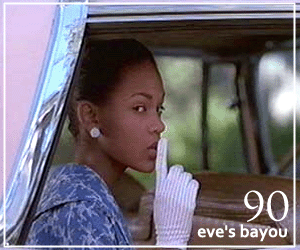 90. Eve's Bayou (Lemmons, 1997)
90. Eve's Bayou (Lemmons, 1997)
“Memory is a selection of images, some elusive, others printed indelibly on the brain… The summer I killed my father, I was ten years old.” So begins Eve’s Bayou, the startling debut film by writer-director Kasi Lemmons. Reflected in the eerie waters of Louisiana bayou country, young Eve, a psychic in training, plays around with serpents and apples, only to gain a new knowledge of her father’s philandering that she is in no way prepared to handle. But Eve’s are baby visions, not so comprehensible as the ghosts Aunt Mozelle sees in her mind's mirror. Lemmons describes Mozelle (played by Debbi Morgan with regal command and a terrifying vulnerability) as a woman "in love with the tragedy of her life." She has buried three husbands, and believes herself cursed. In fact, handsome Dr. Louis Batiste and his sister Mozelle are two of a kind: both healers — one of the body, one of the soul — yet unable to cure themselves of their own sexual compulsions. Cinematographer Amy Vincent’s painterly compositions and brooding camera, the Batistes’ tree-shrouded mansion, costumes rich in 1960s color — even a massive, all-embracing oak branch and a gate without a fence — provide a strong, specific sense of time and place. Yet every scene comes entangled in deep Creole spiritualism, allowing these bayou women to accept, almost without question, the metaphysical forces that inform their daily lives. The story’s ambiguity — the way it plays with memory and point of view — makes us wonder which is truer: reality or our perception of it. In the end, we simply do not know what to believe. Seen through a child’s eyes, the crazy, beautiful Batistes enchant and mystify us, all the while loving each other to death. This is, after all, Eve’s bayou. -Beth Stevens, USA |
 89. Everyone Says I Love You (Allen, 1996)
89. Everyone Says I Love You (Allen, 1996)
In a career that spans five decades and over thirty films, it's difficult to believe that Woody Allen can still surprise us. However, he did just that with the release of his magical musical comedy, Everyone Says I Love You. Best classified as both a celebration of romance and a tribute to the Golden Age's greatest musicals, the film may not have completely won over viewers during its initial 1996 release, but it certainly deserves a second look. They would be hard-pressed to find a more joyous and charming cinematic experience. On the film's opening weekend, Pulitzer Prize-winning film critic Roger Ebert wrote, "Allen knows that what modern musicals are missing is not the overkill of multimillion-dollar production numbers, or the weight of hit songs from the charts, but the feeling that some things simply cannot be said in words, and require songs to say them." With this sentence, Ebert, for lack of a better phrase, hit the nail on the proverbial head. Using standards such as "Cuddle Up a Little Closer," "I'm Through With Love," and "My Baby Just Cares for Me," Allen reminds us of the power of music and the inexplicability of romance. These songs convey our feelings better than any line of dialogue ever could. The musical numbers, staged brilliantly throughout the film, may recall Ginger Rogers-Fred Astaire musicals of the 1930s, but Woody gives the proceedings a contemporary jolt with his trademark wit and sense of humor. As his characters engage in a whirlwind of love and heartbreak that takes them from New York to Paris, Allen skillfully toes the line between comedy and drama. Each critical moment is emphasized by a wonderfully realized musical number that finds Allen at his most creative. For instance, one of the most memorable numbers comes in the form of "My Baby Just Cares for Me," in which Holden (Edward Norton) and DJ (Natasha Lyonne) sing about the former's love of Skylar (Drew Barrymore). This sequence is endlessly charming. From the costume design and department store set pieces, which recall the glossy musicals of yesteryear, to the tap dancing and timeless melody, Allen perfectly captures the joy of love. The true highlight of the film occurs at the end of the picture, when Joe (Woody Allen) and Steffi (Goldie Hawn) perform "I'm Through With Love" along the bank of the Seine River in Paris. As Steffi sings this unforgettable ballad and the pair share a dance, the Paris skyline reflects onto the nearby water, the music swells, and the viewer is simply swept away. The sequence eventually becomes an almost transcendent experience, as Steffi floats effortlessly into the air, the dance continues, and the music plays on. Wistful and poignant, this musical number is not only one of the greatest achievements of Allen's career, but also one of the most romantic moments to grace the silver screen. Rarely has a dance spoken such volumes. Overall, Allen certainly surprised me with the classic and beautiful Everyone Says I Love You. Featuring creative staging, a classic look, timeless songs, and a terrific ensemble cast which includes Edward Norton, Goldie Hawn, Julia Roberts, Alan Alda, Drew Barrymore, Natasha Lyonne, Tim Roth, and Allen himself, it is unforgettable. -EK, USA |
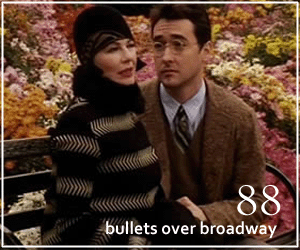 88. Bullets Over Broadway (Allen, 1994)
88. Bullets Over Broadway (Allen, 1994)
“Let's say there was a burning building and you could rush in and you could save only one thing: either the last known copy of Shakespeare's plays or some anonymous human being. What would you do?” Woody Allen’s Bullets Over Broadway brings us artists and intellectuals who just think about sex; an author who can’t write about real life and/or people; huge stage actors either insecure or vain; mobsters who obviously live in another reality; and one hitman who is in fact a hidden writing genius… Our pretentious author (John Cusack) learns that life and people are more important than art itself… While the hitman gets to the point of killing the actress who ruins his art… And Woody Allen makes solid cases for both of them! Bullets Over Broadway, probably my favorite of Allen’s comedies, is the perfect example of what a great director he is… A fact sometimes overshadowed by his writing skills. He never puts his camera in the wrong place and he never misses a nuance. My only complaint would be the lack of close-ups in general. But in an ensemble piece with so many over-the-top characters and performances, that’s a very understandable choice. And what a great ensemble it is! Wiest, Tilly and Palminteri’s Academy Award nominated works aside, Jim Broadbent, Rob Reiner, Tracey Ullman, Joe Viterelli and even Annie-Joe Edwards in her short role (as Viterelli’s hilarious housekeeper Venus) all give pitch-perfect performances with brilliant comedic timing. All in all, this is truly one of Allen’s top works… Finally, let me add that after 15 years, I still laugh out loud when John Cusack yells out of a window in the middle of the night, disturbed that he sold out for his play to be financed… “I’M A WHORE! I’M A WHORE!” I’m sure any artist would relate to that… |
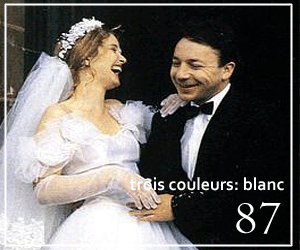 87. Trois couleurs: Blanc (Kieslowski, 1994)
87. Trois couleurs: Blanc (Kieslowski, 1994)
For some reason regarded as the lesser of the three in Kieslowski’s acclaimed ”Three Colours” trilogy, Blanc may not wear its heart on its sleeve with such open audacity as Rouge or with such dedicated sorrow as Bleu, but nevertheless, Blanc may be the more emotional of the three. However, the emotions here simply are not as photogenic or ”pretty” as in the remaining two movies — but may be even more human. Rarely have bitterness and revenge looked as delicious and entertaining as here. As Karol Karol (Zbigniew Zamachowski) feeds off of his failing marriage with French ice queen Julie Delpy, we — like Karol — both root for him to get her back — and for him to get his due, ’cause she is a bitch! But alas, as the film shows us, you can’t have your cake and eat it too, and thus Kieslowski finishes Blanc on a surprisingly somber, sad note, casting a welcome shadow of darkness over the obvious previous hilarity. It is difficult not to cheer for this Polish underdog, lost in a mean, heartless world, but using the same mean, heartless world to get back at the woman he once loved. This brings a broad appeal to Blanc which is both witty and surprising — and serious. -T. Frovin, Denmark |
 86. Trainspotting (Boyle, 1996)
86. Trainspotting (Boyle, 1996)
If it's true that Pulp Fiction, 1994, defined a decade and expanded the concept of the post-modern, the true turning point, by a social point of view, of the '90s in film was represented by a handful of films released between 1994 and 1996. Directors in their thirties offered a new, bittersweet outlook at their generation. And of all the films dealing with Gen X, or Gen X-influenced characters, Danny Boyle's Trainspotting is, still to this day, the toughest, the boldest and the most iconic. In a perfect combination of music video atmospheres, an acrobatic use of the camera, acting so over-the-top that it borders on the grotesque, Boyle and screenwriter John Hodge were able to adapt the extreme world of author Irvine Welsh, in a film that is tough and raw and visionary and dreamy and truthful and shocking and crazy and hysterical, all at the same time. Through the pseudo-philosophical, smart and provocatively juvenile thoughts of Rents, the modern hero/antihero carried away by the boredom of his own life, we follow the (mis)adventures of a group of friends, each with his personal story, each with his background and each with his own obsession and/or addiction. And what makes this film still relevant and loved is the ability of Boyle and Hodge to show all the facets of these characters, intruding in their everyday affairs and their tragedies alike, their silly and childish joking around as well as their daily struggle with addiction. After more than ten years Trainspotting is still fresh and catchy, tragic in its shallowness, joyfully gross and falsely hopeful — the perfect representation of all the extremes of youth of a decade that struggled to find its own personality. |
 85. The Nightmare Before Christmas (Selick, 1993)
85. The Nightmare Before Christmas (Selick, 1993)
It might seem easy just to dismiss the achievement of Henry Selick’s The Nightmare Before Christmas due to the embracement of the film by the goth and emo subcultures. Surely a film that sells merchandise in your local Hot Topic store can’t be worthwhile, right? To take this view is a complete disservice to the achievement of Selick and Tim Burton. While the narrative of the film might not achieve anything revolutionary, it’s hard not to still fall in love with it. Borrowing almost exactly from the standard “Hero’s Journey” arc, the film makes us care about and encourage Jack Skellington’s takeover of Christmas, even if we understand that what he’s doing is wrong. How could you not root for a character as endearing as Jack Skellington? We can all relate to that sense of complacency and loss of interest in something we used to love, so even if we might never have seen a walking, talking, dancing skeleton, we can relate to his plight and his struggle. Add to that the brilliant voicework from Danny Elfman and Chris Sarandon and you have an iconic character we can all identify and sympathize with. Giving him some of the most recognizable songs from any film in the past twenty-five years (“Jack’s Lament,” “Jack’s Obsession,” “What’s This?” to name a few) only adds to his legacy. Of course, Jack isn’t the only iconic character from the film. There’s a plethora of those, from Sally the Rag Doll to Santa Claus, from Lock, Shock, and Barrel to the Oogie Boogie Man, and even the ghostly, devoted Zero. All defined personalities aided by superb voicework and excellent character design. And this is where the film really triumphs: the design. The level of detail put into the extensive miniature sets for both Halloween Town and Christmas Town (and every other location and character used in the film) is staggering and completely awe-inspiring, creating a playground for the imagination. Drawing on German Expressionist influences, Halloween Town is a macabre nightmare, yielding surprises and interest with each viewing. Christmas Town, on the other hand, is the flip side. Where a monochromatic, black-and-white color scheme prevails in Halloween Town, here we have a saturated abundance of color and light, with whimsy at every turn. Brimming with excitement and intrigue, these are simply some of the most imaginative, well-crafted miniatures in film history. The Nightmare Before Christmas might not be considered the greatest film of the '90s, or maybe even its year, but few films have an artistic vision as fully realized as this one. The direction, screenwriting, cinematography, art direction, editing, and score all come together to create a defining and iconic film. -N. McIntyre, USA |
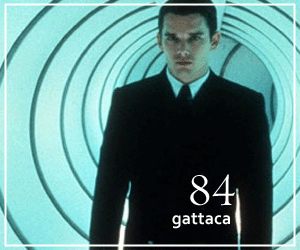 84. Gattaca (Niccol, 1997)
84. Gattaca (Niccol, 1997)
Andrew Niccol’s Gattaca is a film of longing. It tells of humans longing for perfection in a world that allows for it and one imperfect man longing for a world that allows for him. Its title is composed of the four letters of the genetic code, as are we all, and the film is about the separate pieces we bring together in order to create our own identities; it is about the way the world forces identities onto us; it is about the daily struggle to become something, anything. In a way it is even a parallel to the billion-year struggle by matter that has, at this brief period in time, resulted in Homo sapiens. Ethan Hawke is Vincent Freeman. He lives in a not-so-distant future where genetic modification has allowed for custom-ordered children who come out stronger, faster, smarter and healthier. Vincent was born without such genetic advantages. With a weak heart and bad eyesight he’s a blotch on society. He’s seen as inferior and treated as such without anyone ever needing to speak with him. He is fit to clean floors and watch the astronauts at space-agency Gattaca’s headquarters. He is not fit ever to join their ranks. Through the course of the film he attempts to prove the world wrong. What makes the film compelling is that it is not anti-genetic modification. The characters around Vincent are healthier than he, some are smarter. But he, too, is brilliant and is able to outwit many of them. Both sides have merit. There is great benefit in helping avoid birth defects and genetic disease and Gattaca understands this. It is more concerned with being cognizant of humanity than it is with condemning science. Indeed, the beauty and possibility of Vincent’s world is represented by rocket ships — a hallmark of scientific achievement. As we watch Vincent outsmart the supposedly superior people around him, we begin to see that genetic modification can certainly increase the odds of greatness, but it’s important to remember that it still occurs naturally all the time as well. Gattaca is a very scientific film, yet at its most basic it is about the unscientific soul. Human shells can be perfected, or nearly so, but that is not the whole story. Niccol is not warning us to avoid genetic modification but to keep in mind its limitations. There is more to Vincent than meets the eye and there is more to humanity than four letters arranged in a specific order. |
 83. The Crying Game (Jordan, 1992)
83. The Crying Game (Jordan, 1992)
Back in 1992, The Crying Game was a sensational hit with a huge and unexpected twist cleverly used as a marketing device by Miramax. Revisiting the film recently, I couldn’t help wondering how we fell for it (the twist) then, but it was also clear that the film’s strength had nothing to do with that surprise effect. Neil Jordan’s "beautifully shot in wide-screen" film tries an unusual mixture of political drama (I.R.A. conflict), Hitchcockian love and suspense story (reminiscent of Vertigo at times), and gender issues. Fergus (Stephen Rea) falls in love with Dil. Right before the turning point of the film, Dil walks out of the bathroom of her apartment to reveal who she really is, and the green light reflecting on her body connects Dil unquestionably to Kim Novak’s Madeleine in Hitchcock’s above-mentioned masterpiece. But can Fergus still love her after learning that she’s not the girl he thought her to be? Another Vertigo reference is clearly Miranda Richardson’s Jude in disguise. When she reappears in the second half of the film, we see her dressed in a grey suit with a dark red wig, reminiscent of Judy Barton. So both women in the film are represented with Vertigo references. They are complete opposites, but maybe also the two sides of the female. Jude is demanding and deceitful under that political activist appearance, while Dil is fragile and timid despite her brazen queer attitude. How could a mixture of I.R.A. suspense and an unorthodox love story this close to melodrama work so well? A film which starts with “When a Man Loves a Woman” and ends with “Stand by Your Man”… A film so cheesy and so '80s at times… Apart from a director who knows what he’s doing very well and a cast which never hits a false note, it still all comes down to the screenplay. The Crying Game’s Academy Award for the Best Original Screenplay may have been kind of a consolation prize in the race against Clint Eastwood’s deconstructive western masterpiece Unforgiven. But it was a highly deserved win anyway. Tightly structured without a single unnecessary scene or bit of dialogue, Jordan's story makes us believe in and care for his characters and their conflicts. A film that combines all those elements so smoothly may only come once in a very long time… |
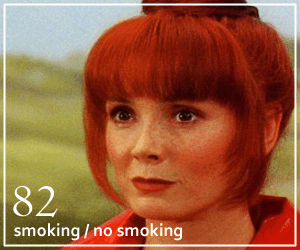 82. Smoking/No Smoking (Resnais, 1993)
82. Smoking/No Smoking (Resnais, 1993)
In his 1993 César-winning film Smoking/No Smoking, Alain Resnais continues his exploration of the recurring themes of memory and time. A revered master in French cinema, Resnais is famous for his strict formalism and socio-political sensibilities. Although these are less obvious here compared to his older films like Last Year at Marienbad or Hiroshima mon amour, they still permeate this double bill of a film feature. Smoking and No Smoking are actually two films or two segments of one film, depending on how one deconstructs them. It is ultimately pointless to argue semantics but it cannot be debated that these two are united by their common thesis: the "what if?" scenarios. Surely, we have asked these questions in our life and Resnais captures our curiosity with such playfulness. The parallel juxtaposition of the two segments is made obvious by the choices that the characters make. For example, a character quits smoking in one segment while continuing to chain-smoke in the other. In a true homage to Bollywood cinema, Sabine Azema plays all five female characters while Pierre Arditi plays all four male characters. Filled with characteristic British humour but retaining a certain French sensibility, Smoking/No Smoking may be the funniest of Resnais' films. But fun and comedy do not decrease Resnais' stature as a leviathan filmmaker. In true auteurist fashion, this film is handled by Resnais with such audacity. No matter what genre he works in, he is able to preserve and enrich his creative vision. With Smoking/No Smoking, Resnais proves once again that he is both a masterful metteur en scène and realisateur — one who can realize words into scenes that will last forever. -CDMC, Canada/Philippines |
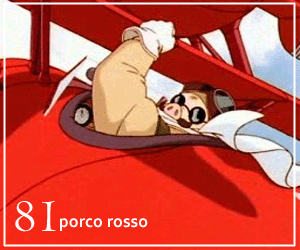 81. Porco Rosso (Miyazaki, 1992)
81. Porco Rosso (Miyazaki, 1992)
An oddity in Hayao Miyazaki’s canon from the moment he decided to have a protagonist that is not a child or a teenager, Porco Rosso remains the master’s most adult and somewhat most bitter of his movies, and also the rare hidden gem that the connoisseurs of his oeuvre love to find after watching his more famous but not necessarily better films. Conceived, at least in shape and tone, as a homage to Hollywood and European old adventure/romance movies of the '30s, with Hawks and Renoir among its influences, it however flies into 100% Miyazaki territory not only because of the, once again, breathtaking and unique visual design, but also because of the subtlety and imagination (despite being his most realistic and specifically set work) with which its concerns are expressed. The film basically moves around a group of characters that try to remain human in a world that’s dehumanizing more and more, the Italy of the '30s after the first World War and the economic depression, and during the rise of fascism. But Miyazaki introduces subtle touches of his fantasy and, most of all, tells this story about remaining human with ambiguous allegories and unresolved questions that make the whole thing one of the most poetic and inspiring tales of humanity during harsh times ever told. -Jaime Esteve, Spain |
| © 2010 INTERNATIONAL CINEPHILE SOCIETY. ALL RIGHTS RESERVED. | ICS - 100 - 90 - 80 - 70 - 60 - 50 - 40 - 30 - 20 - 10 |